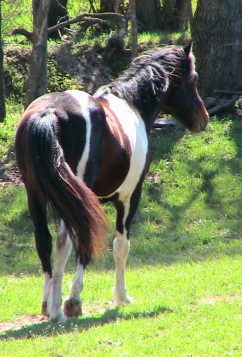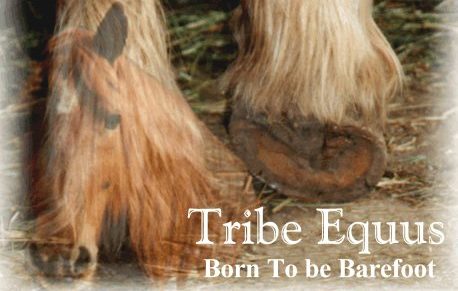
"All too little attention has been paid to the 'natural' foot. That's the way he was made, that's the way he should go."
~ J. R. Rooney, DVM - author, The Lame Horse ( © 1998)
Providing for the Natural Horse
A High Performance Barefoot Horse is not just a horse without shoes.
It is a change in long-standing beliefs about what is proper horsekeeping.
It is a horse that is given the basic biological requirements for health, long life and soundness.
It is a return to the way of the Natural Horse
In nature, wild horses have adapted to the various terrain and climates in which they live. They are free to roam 24 hours a day, seven days a week, 365 days a year. While many will argue that wild horses, such as those in the American West, are profoundly different - genetically - from their domestic relatives, that is simply not the case.
Horsemen in all camps, including farriers and vets, agree that the American Mustang is hardier (particularly their feet) than domestic horses and most believe it is in the genes. Let's look at that argument for a moment....
America's "wild Mustang" are of the Family: Equidae, Species: Equus caballus. So are all domestic horses. While it is certain that some genetic variations will exist among members of the same species (size, shape, color, gaits), all modern horses are basically physiologically the same and have the same basic needs. Looking at the history of those hardy Mustangs, we realize that they are a genetic mix of horses. First were those brought by Spanish conquistadors when they came to the Americas in the early 1500s. Many Spanish horses escaped or were turned loose and became feral or wild. They formed the nucleus of the great herds of wild horses that spread upward from Mexico into the United States and the western plains country. Later, wild (feral) horse populations were infused with other domestic blood from horses that escaped from farmers and ranchers, cavalry remounts running loose when not in service, and in the early 20th century many horses were turned loose during the Great Depression when their owners could no longer afford to care for them. Mixing and blending of bloodlines over just 500 years has resulted in today's American Mustang. On a genetic level there is little difference between them and domestic horses - there simply hasn't been enough time, in an evolutionary sense, for genetic mutations of any significance to occur.
So how is it that these wild Mustangs living on marginal land have developed such tough, durable feet that require no intervention from man to remain sound? If it is a result of natural selection leaving only those with the best feet alive to reproduce, how is it that Mustangs taken into captivity soon exhibit the same foot ailments and weaknesses and other health problems that plague domestic horses? We believe that environment is the largest single factor:
Wild Equus
- is free-roaming, 15-20 miles per day
- has a herd life
- has a vast nutritional variety allowing him to eat what he needs when he needs it and in the amounts he needs
- seeks out certain minerals when the body needs supplementation to the diet
- eats and drinks in a natural, head-lowered position
- exposes his feet to water each day as he drinks from rivers, streams, or lakes
- experiences gradual temperature changes, naturally out in the open
- wears no blankets, hoods, or wraps
- has bare hooves with direct ground contact
- sleeps on the ground
- moves over a varied, often rugged terrain
Domestic Equus
- is stall or paddock bound with little movement
- is often confined in solitude
- is fed highly concentrated rations at infrequent intervals each day, may go hours with nothing in his stomach
- is forced to eat fortified rations and supplements in varied amounts that the body may not need
- eats and drinks from buckets and feeders with head in an unnaturally high position
- has little or no daily opportunity to wet his feet, has oil/grease preparations applied to his feet instead
- experiences sudden temperature changes moving from barn to paddock, or when blankets are removed
- wears blankets, hoods, and wraps
- has shod hooves with little to no direct ground contact
- sleeps on soft bedding
- moves on prepared often very soft terrain
How can I provide a natural environment for my horse?
First educate yourself as much as possible about the natural horse.
An excellent place to start is with our list of recommended reading.Next, walk around your barn or stable (or wherever your horses are housed) with a critical eye. Ask yourself these questions:
- Is my horse able to move about 24/7 or is he in a stall some, or most of the time?
- Does my horse have at least one equine companion to satisfy his need for a herd life and to stimulate him to move?
- Does he have a varied terrain to move on, or is he mostly in soft sand or lush pasture?
- Does my horse wear shoes?
- Does my horse have access to a wet area so that his feet are exposed to water as needed?
- Does my horse have access to 24 hour foraging, or is he fed 2 or 3 meals each day?
- Can my horse eat and drink with his head in a naturally lowered position?
Those are some basic questions you should ask yourself if you desire to provide as natural a lifestyle as possible for your equine companion.
Now that you've answered these questions, what steps can you take to improve the situation for your horse?
- Avoid stalling your horse. If you board your horse, ask for 24 hour turnout or switch to pasture board. If your facility cannot provide adequate turnout, look for another place.
- Provide at least one other horse as a companion for yours. Consider taking in a rescue horse, or ask around where you live. There may be another horse owner with a single, lonely horse who is willing to team up with you in a mutually beneficial relationship.
- Walk around your pasture or turnout area. If it is all smooth, soft terrain, consider placing patches of river rock or gravel in various locations to help condition your horse's bare feet.
- If your horse wears shoes....REMOVE THEM and apply a natural barefoot trim (different from what farrier's call a "pasture trim"). Talk to your veterinarian and farrier about your plan for your horse and enlist their support. You may meet with resistance because conventional beliefs are very strong. If they will not work with you, find another vet or farrier who will....or better yet, find a barefoot trimmer...OR (as many horse owners have had to do)...learn to do it yourself. It may take time for your horse's feet to toughen and get used to life without shoes - just as your bare feet probably wouldn't feel comfortable on rocks until they were toughened and calloused. Feet need to be conditioned, but some horse owners simply do not ride enough to do the job. Use hoof boots during the transition to barefoot or if your horse is ridden so infrequently that he has difficulty on rougher terrain. Boots are worn only when needed and do not damage the foot or interfere with the natural function of the foot the way horseshoes do.
- If there are no open bodies of water where your horse lives (stream, pond, etc) get creative! Create some area where the horse can get his feet wet if he needs to. Do not, however, force the horse to wet his feet. Simply allow access to a wet area and the horse will walk throuhg/stand in it as needed to balance the moisture in the feet.
- Horses evolved to eat small amounts almost continuously. Their stomach lining is only partially protected from the ravages of digestive acids by a special coating. If their stomach is allowed to fully empty (something not intended by nature) the horse is at high risk for the development of ulcers. Recent studies indicate that virtually all domestic, conventionally boarded horses have some degree of damage to their stomach lining. Your horse should have free choice access to good quality grass hay or pasture grazing around the clock. Grain mixtures and processed pelleted feed should be eliminated from the diet. Instead whole grains (oats, corn, etc.) should be fed in frequent small amounts if the horse requires extra energy. Branches from edible trees, fruits, even vegetable kitchen scraps add variety to the diet. Your horse will eat what he needs and simply ignore what he does not. Note: Use common sense when beginning natural feeding and introduce new free choice items in small amounts over time. Horses that have been denied choices for years (or their lifetime) may over-indulge at first.
- Watch your horse when he is loose in the pasture. How does he prefer to eat? Horses naturally eat with their head lowered to the ground, yet conventional boarding practices insists that he eat with his head chest high (or even higher!). Since your natural horse will no longer be stall bound, manure going into the feed bin will no longer be a big concern. Lower the bin or feed in large rubber feed pans. Put his hay on the ground - it is how he was meant to eat.
WHEW!!! A lot to think about!Restoring the Natural Horse is a big change from what most of us had always been taught about how to care for a horse. It is a big adjustment to make, but once made, your horsekeeping time is cut down to practically nothing, which leaves a lot more time for.........RIDING!
Don't worry, there are people out there who are willing to share their experiences and ideas with you and help you through the rough spots.... and they do it all for the love of horses. Here's a list.
